day35-IO流02
JavaOI流02
4.常用的类
4.1文件字节流输入流-FileInputStream
InputStream抽象类是所有类字节输入流的超类
InputStream常用的子类:
- FileInputStream:文件字节输入流
- BufferedInputStream:缓冲字节输入流
- ObjectInputStream:对象字节输入流
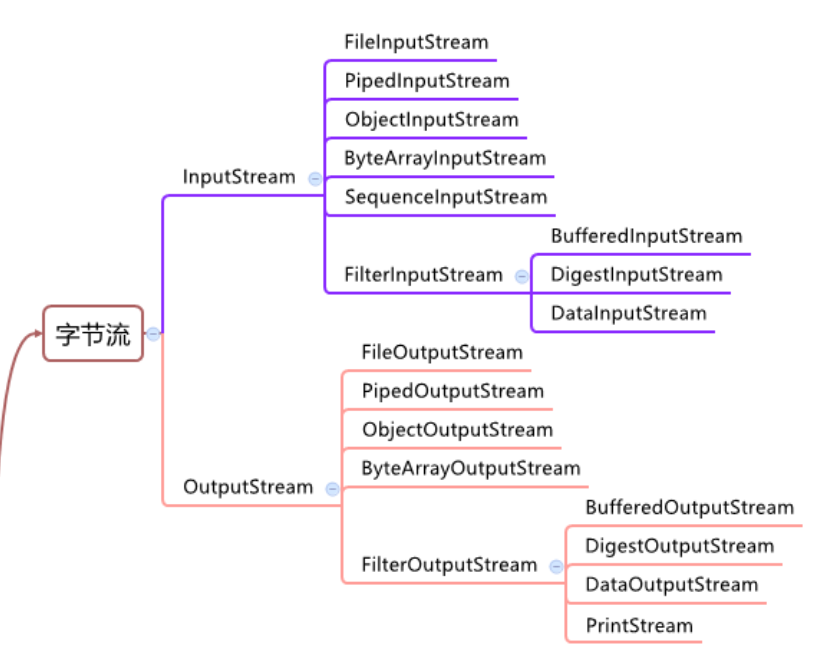
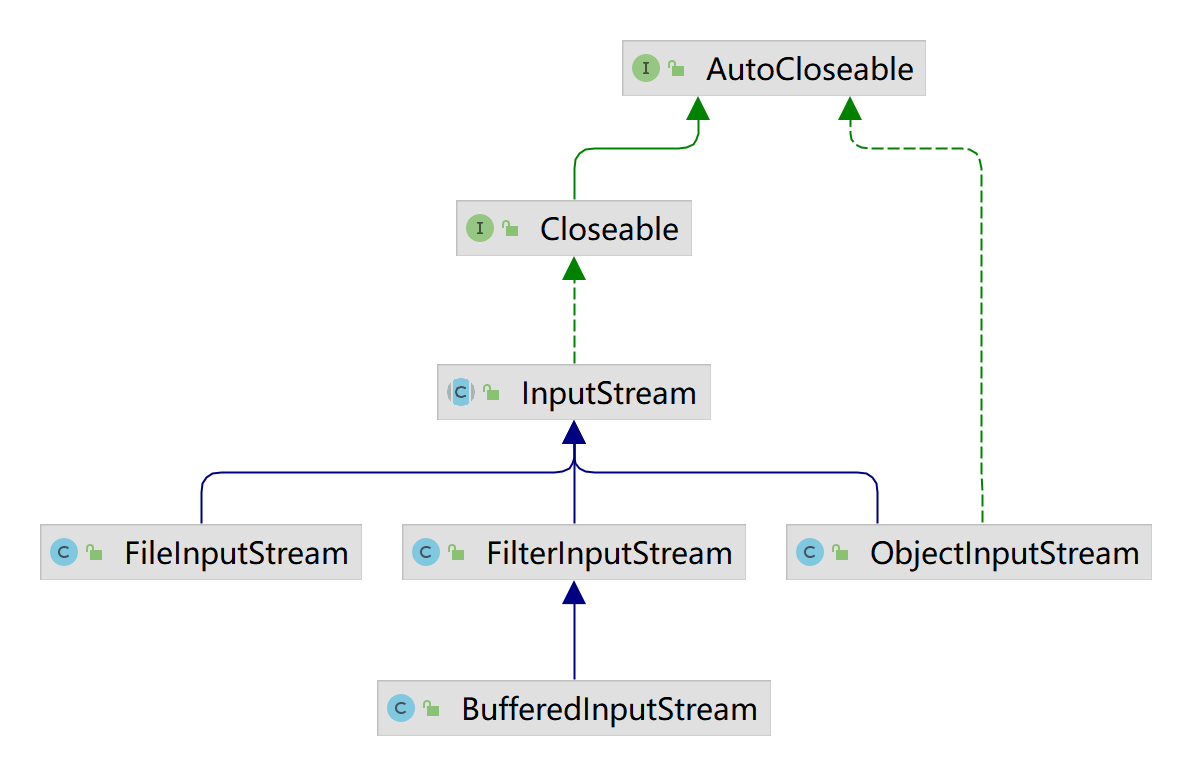
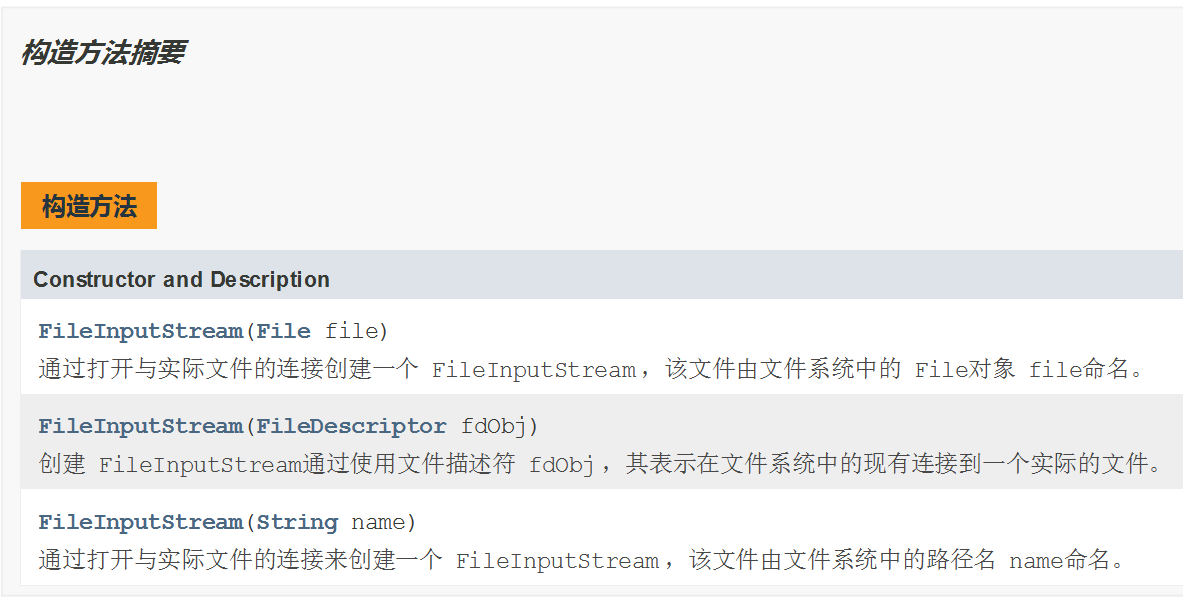
常用方法:
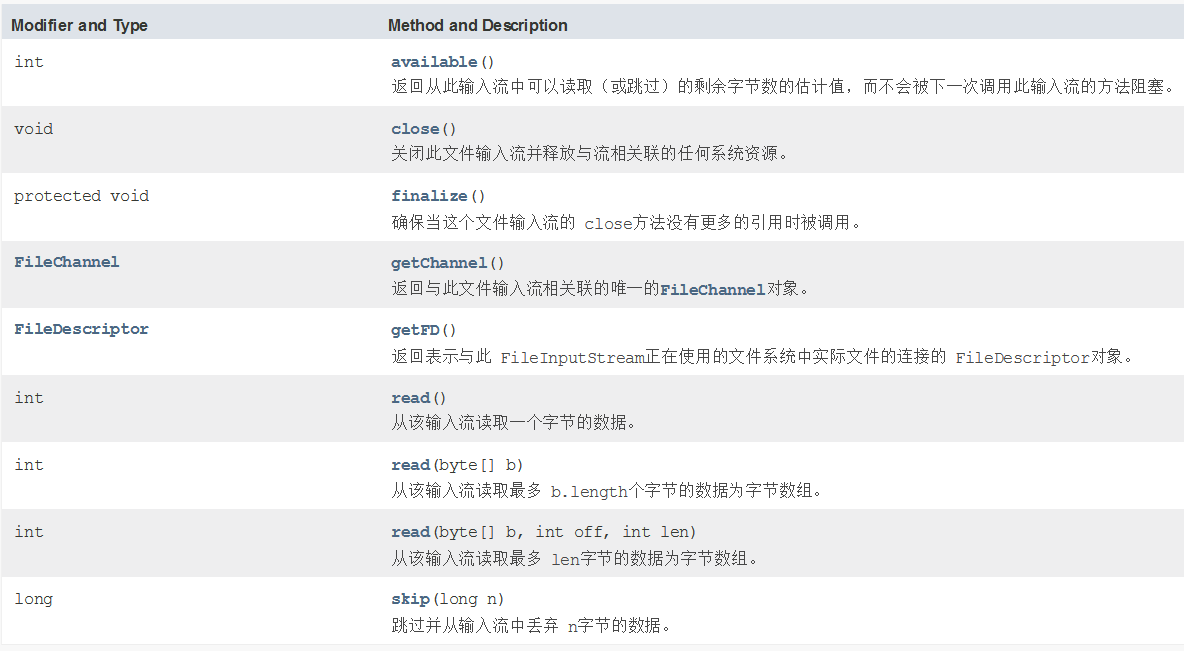
输入流的唯一目的是提供通往数据的通道,程序可以通过这个通道读取文件中的数据。
read方法提供了一个从输入流读取数据的基本方法,read方法的格式如下:
| 返回值 | 方法 | 说明 |
|---|---|---|
| int | read( ) | 从输入流中读取数据的下一个字节 |
| int | read(byte[ ] b) | 从输入流中读取一定数量的字节,并将其存储在缓冲区数组 b 中。以整数形式返回读取的字节数。 |
| int | read(byte[ ] b, int off, int len) | 将输入流中最多 len 个数据字节读入 byte 数组。尝试读取 len 个字节,但读取的字节也可能小于该值。以整数形式返回实际读取的字节数。 |
| void | close( ) | 关闭流 |
注:read方法在从输入流中读取源中的数据时,如果到达源的末尾,便会返回-1。
FileInputStream流顺序地读取文件,只要不关闭流,每次调用read方法就顺序的读取源中其余的内容,直至源的末尾或流被关闭。
例子:
package li.io.inputstream_; import org.junit.jupiter.api.Test; import java.io.FileInputStream; import java.io.IOException; //演示FileInputStream的使用(字节输入流 文件-->程序) public class FileInputStream_ { public static void main(String[] args) { } /** * 演示读取文件 * read():单个字节的读取,效率较低 */ @Test public void readFile01() { String filePath = "d:\\hello.txt"; int readData = 0; FileInputStream fileInputStream = null; try { //创建了FileInputStream对象,用于读取文件 fileInputStream = new FileInputStream(filePath); //read()方法:从该输入流读取一个字节的数据。 如果没有输入可用,此方法将阻止。 //如果返回-1,则表示达到文件的末尾,表示读取完毕 while ((readData = fileInputStream.read()) != -1) { System.out.print((char) readData);//转成char显示,因此如果文件里面有中文字符(每个中文字符占三个字节),显示的时候就会出现乱码 } } catch (IOException e) { e.printStackTrace(); } finally { //关闭文件流,释放资源 try { fileInputStream.close(); } catch (IOException e) { e.printStackTrace(); } } } /** * 使用read(byte[] b)读取文件,提高效率 */ @Test public void readFile02() { String filePath = "d:\\hello.txt"; //字节数组 byte[] buf = new byte[8];//一次读取8个字节 int readLen = 0; FileInputStream fileInputStream = null; try { //创建了FileInputStream对象,用于读取文件 fileInputStream = new FileInputStream(filePath); //read(byte[] b)方法:从该输入流读取最多b.length字节的数据到字节数组。 //如果返回-1,则表示达到文件的末尾,表示读取完毕 //如果读取正常,返回实际读取的字节数 while ((readLen = fileInputStream.read(buf)) != -1) { System.out.print(new String(buf, 0, readLen));//显示 } } catch (IOException e) { e.printStackTrace(); } finally { //关闭文件流,释放资源 try { fileInputStream.close(); } catch (IOException e) { e.printStackTrace(); } } } }
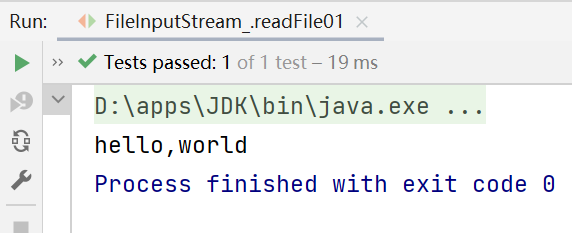
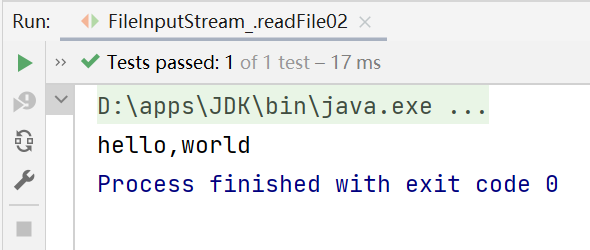
4.2文件字节输出流-FileOutputStream
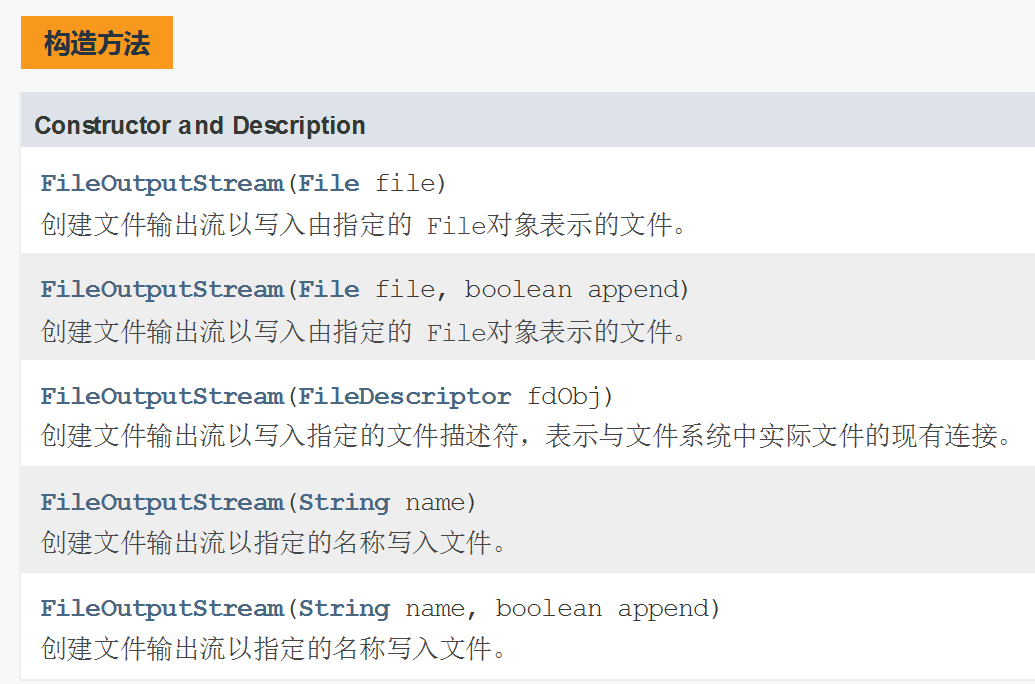
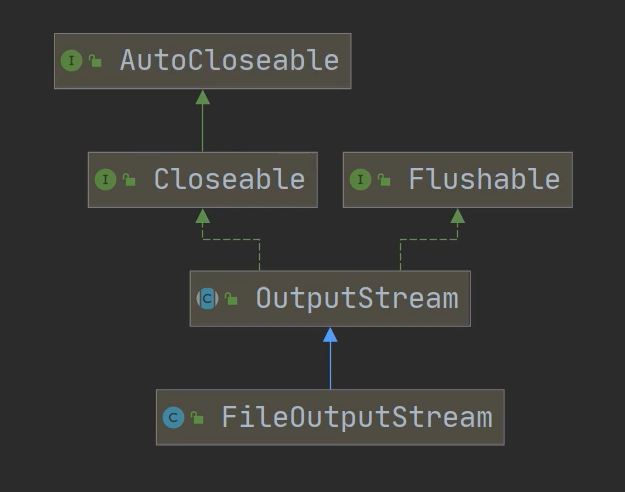
常用方法:

例子:FileOutputStream应用实例1
要求:请使用FileOutputStream在a.txt文件中写入“hello,world”。如果文件不存在,就先创建文件。
(注意:前提是目录已经存在)
package li.io.outputstream_; import org.junit.jupiter.api.Test; import java.io.FileOutputStream; import java.io.IOException; public class FileOutputStream_ { public static void main(String[] args) { } /** * 演示使用FileOutputStream将数据写到文件中,如果该文件不存在,则先创建文件 */ @Test public void writeFile() { String filePath = "d:\\a.txt"; //创建FileOutputStream对象 FileOutputStream fileOutputStream = null; try { //得到一个FileOutputStream对象 /* 如果是以new FileOutputStream(filePath)的方式创建对象, 则当写入内容时,会覆盖原来的内容 如果是以new FileOutputStream(filePath,true)的方式创建对象, 则当写入内容时,是在旧内容的末尾追加新内容 */ fileOutputStream = new FileOutputStream(filePath,true);//以追加的形式去添加新内容 //写入一个字节 //fileOutputStream.write('H'); //写入字符串 String str = "Hello,Jack!"; //String的getBytes方法可以将字符串转为字符数组 // fileOutputStream.write(str.getBytes()); /* write(byte[] b,int off,int len) 将len长度的字节从位于偏移量off的指定字节输入写入此文件输出流 */ fileOutputStream.write(str.getBytes(), 0, 4); } catch (IOException e) { e.printStackTrace(); } finally { try { fileOutputStream.close(); } catch (IOException e) { e.printStackTrace(); } } } }
追加前: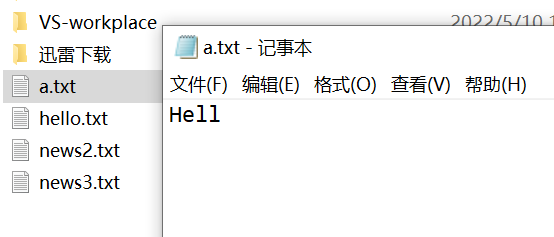
追加后: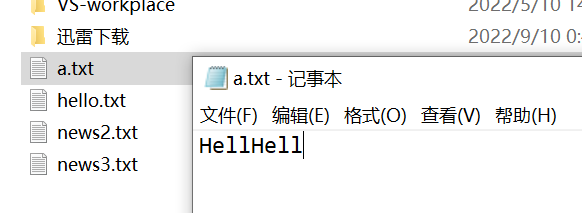
4.2.1FileInputStream&&FileOutputStream
应用实例2:文件拷贝
要求:完成文件拷贝,将d:\Koala.png拷贝到d:\Koala222.png

在完成程序时,为防止读取的文件过大,应该是每读取部分数据,就写入到指定文件,这里使用循环。
package li.io.outputstream_; import java.io.FileInputStream; import java.io.FileOutputStream; import java.io.IOException; public class FileCopy { public static void main(String[] args) { //完成文件拷贝,将c:\\Koala.png拷贝到d:\\ /* 思路分析: 1.创建文件的输入流,将文件读入到程序 2.创建文件的输出流,将读取到的文件数据写入指定的文件 */ String srcFilePath = "d:\\Koala.png"; String destFilePath = "d:\\Koala222.png"; FileInputStream fileInputStream = null; FileOutputStream fileOutputStream = null; try { fileInputStream = new FileInputStream(srcFilePath); fileOutputStream = new FileOutputStream(destFilePath, true); //定义一个字节数组,提高效率 byte[] buf = new byte[1024];//1K int readLen = 0; while ((readLen = fileInputStream.read(buf)) != -1) { //读取到后,就通过 fileOutputStream写入到文件 //即,是一边读一边写) fileOutputStream.write(buf, 0, readLen);//一定要使用这个方法 } System.out.println("拷贝成功~"); } catch (IOException e) { e.printStackTrace(); } finally { //关闭输入流和输出流,释放资源 try { if (fileInputStream != null) { fileInputStream.close(); } if (fileOutputStream != null) { fileOutputStream.close(); } } catch (IOException e) { e.printStackTrace(); } } } }
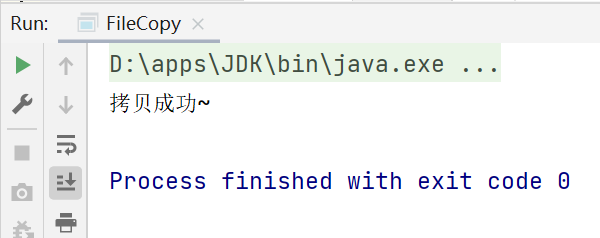
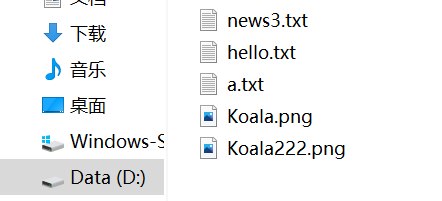
4.3文件字符流FileReader&FileWriter
FileReader和FileWriter是字符流,即按照字符来操作IO
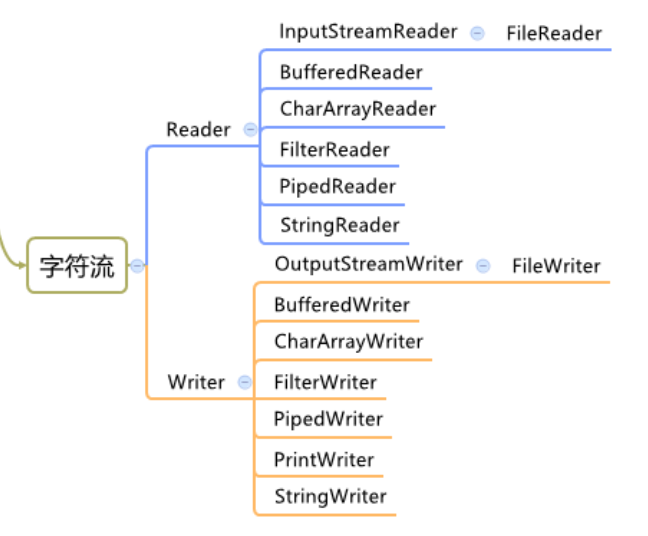
4.3.1FileReader
FileReader相关方法:
构造方法:
public FileReader(String fileName) throws FileNotFoundException //在给定从中读取数据的文件名的情况下创建一个新 FileReader。 //fileName - 要从中读取数据的文件的名称
public FileReader(File file) throws FileNotFoundException //在给定从中读取数据的 File 的情况下创建一个新 FileReader。 //file - 要从中读取数据的 File
常用方法:
public int read() throws IOException //每次读取单个字符,返回该字符,如果到文件末尾返回-1 public int read(char[] ) throws IOException //批量读取多个字符到数组,返回读取到的字符数,如果到文件末尾就返回-1 public void close() throws IOException //关闭该流并释放与之关联的所有资源。
相关API:
-
new String(char[]):将char[]转换成String
-
new String(char[],off,len):将char[]的指定部分转换成String
例子:使用FileReader从story.txt读取内容,并显示
先在d盘根目录下下新建一个story.txt文件,放入内容
package li.io.reader_; import org.junit.jupiter.api.Test; import java.io.FileReader; import java.io.IOException; public class FileReader_ { public static void main(String[] args) { } /** * 1.使用public int read() throws IOException * 每次读取单个字符,返回该字符,如果到文件末尾返回-1 */ @Test public void readerFile01() { String filePath = "d:\\story.txt"; FileReader fileReader = null; int data = 0; //1.创建一个FileReader对象 try { fileReader = new FileReader(filePath); //循环读取 使用reader():每次读取单个字符,返回该字符,如果到文件末尾返回-1 while ((data = fileReader.read()) != -1) { System.out.print((char) data);//将int类型强转为char类型 } } catch (IOException e) { e.printStackTrace(); } finally { try { if (fileReader != null) { fileReader.close(); } } catch (IOException e) { e.printStackTrace(); } } } /** * 2.public int read(char[] ) throws IOException * 批量读取多个字符到数组,返回读取到的字符数,如果到文件末尾就返回-1 */ @Test public void readerFile02() { String filePath = "d:\\story.txt"; FileReader fileReader = null; int readLen = 0; char[] buf = new char[8];//每读取8个字符输出一次 //1.创建一个FileReader对象 try { fileReader = new FileReader(filePath); //循环读取 使用reader(char[]):批量读取多个字符到数组,返回读取到的字符数, // 如果到文件末尾就返回-1 while ((readLen = fileReader.read(buf)) != -1) { System.out.print(new String(buf, 0, readLen));//将char[]的指定部分转换成String } } catch (IOException e) { e.printStackTrace(); } finally { try { if (fileReader != null) { fileReader.close(); } } catch (IOException e) { e.printStackTrace(); } } } }
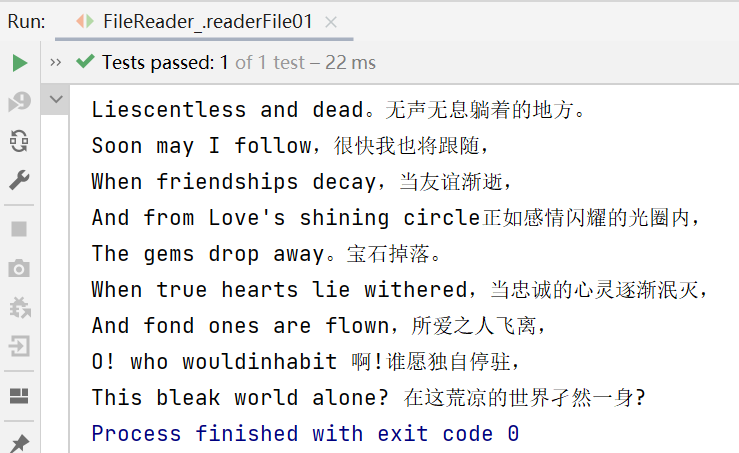
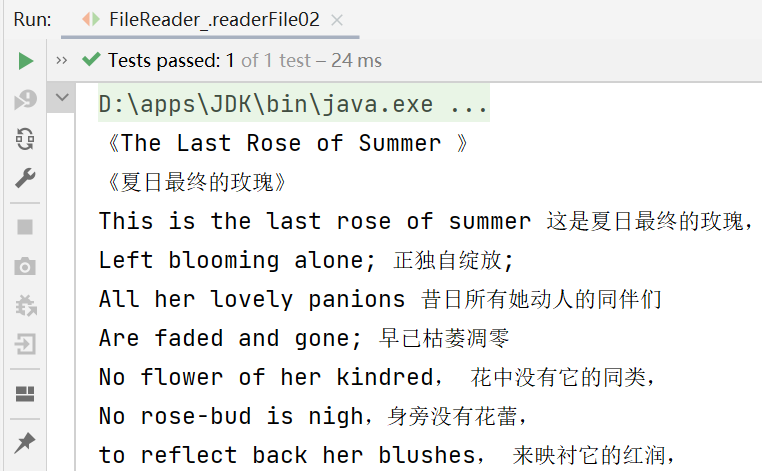
4.3.2FileWriter
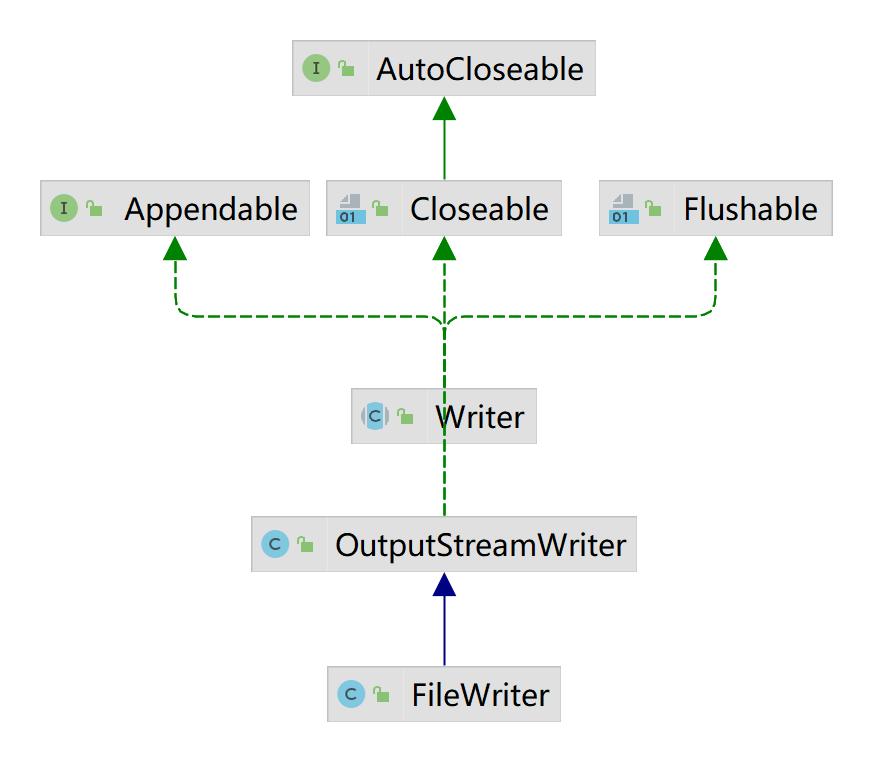
FileWriter常用方法:
构造方法:
public FileWriter(String fileName) throws IOException //根据给定的文件名构造一个 FileWriter 对象。 //fileName - 一个字符串,表示与系统有关的文件名。
public FileWriter(String fileName,boolean append) throws IOException //根据给定的文件名以及指示是否附加写入数据的 boolean 值来构造 FileWriter 对象。 //fileName - 一个字符串,表示与系统有关的文件名。 //append - 一个 boolean 值,如果为 true,则将数据写入文件末尾处,而不是写入文件开始处。 //(即覆盖和追加)
public FileWriter(File file) throws IOException //根据给定的 File 对象构造一个 FileWriter 对象。 //file - 要写入数据的 File 对象。
常用方法:
public void write(int c): //写入单个字符 public void write(char[] cbuf): //写入字符数组 public abstract void write(char[] cbuf, int off, int len): //写入字符数组的指定部分 public void write(String str): //写入字符串 public void write(String str,int off, int len): //写入字符串的指定部分 public void flush() throws IOException //刷新该流的缓冲。 public void close() throws IOException //关闭此流,但要先刷新它
相关API:String类:toCharArray:将String转换成char[]
注意:FileWriter使用后,必须要关闭(close)或刷新(flush),否则写入不到指定的文件!
例子:
package li.io.writer_; import java.io.FileWriter; import java.io.IOException; public class FileWriter_ { public static void main(String[] args) { String filePath = "d:\\note.txt"; FileWriter fileWriter = null ; char[] chars = {'a','b','c'}; //创建FileWriter对象 try { //覆盖模式写入,覆盖是建立在执行close()之后 fileWriter = new FileWriter(filePath); //public void write(int c):写入单个字符 fileWriter.write('H'); //public void write(char[] cbuf):写入字符数组 fileWriter.write(chars); //public abstract void write(char[] cbuf, int off, int len):写入字符数组的指定部分 fileWriter.write("小猫想睡觉".toCharArray(),0,2); //public void write(String str):写入字符串 fileWriter.write("你好北京~"); //public void write(String str,int off, int len):写入字符串的指定部分 fileWriter.write("上海天津",0,2); } catch (IOException e) { e.printStackTrace(); }finally { //对应FileWriter,一定要关闭流,或者flush才能真正地白数据写入到文件中 try { fileWriter.close(); } catch (IOException e) { e.printStackTrace(); } } } }

在数据量大的情况下,可以使用循环操作
思考:为什么关闭流(close)或者flush才能真正地把数据写入文件中?
IO缓冲流的flush()和close()方法说明及写入文件
fileWriter.close 和fileWriter.flush的区别:
实际上,当我们写好new FileWriter ,进行下一步的操作,将数据写入文本的时候,这时的数据并没有写入文本,而是存在了计算机中的流中。这也是JAVA能够在Windows 系统中调用文本流的作用。而如果在这里我们使用fileWriter.flush,是可以将存储在计算机流中的数据放入fileWriter对象的,但是如果我们之后再想加入数据的时候,也就是说我们将写入数据这句话放在fileWriter.flush之后的话,之后输入的数据就不会放入到note.txt中去。
再说一说fileWriter.close, 我们可以去查询close的定义,很明确的写了 先刷新一次,然后关闭数据流。也就是说close是包含了两步,flush 和close 这两步。flush 刷新后,流可以继续使用,close刷新后,会将流关闭。





【推荐】国内首个AI IDE,深度理解中文开发场景,立即下载体验Trae
【推荐】编程新体验,更懂你的AI,立即体验豆包MarsCode编程助手
【推荐】抖音旗下AI助手豆包,你的智能百科全书,全免费不限次数
【推荐】轻量又高性能的 SSH 工具 IShell:AI 加持,快人一步
· 阿里最新开源QwQ-32B,效果媲美deepseek-r1满血版,部署成本又又又降低了!
· 单线程的Redis速度为什么快?
· SQL Server 2025 AI相关能力初探
· AI编程工具终极对决:字节Trae VS Cursor,谁才是开发者新宠?
· 展开说说关于C#中ORM框架的用法!